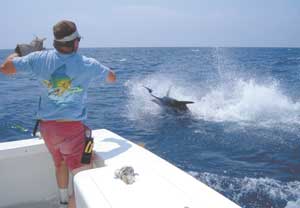
Anglers everywhere have something in common, whether fishing in freshwater or saltwater fishing — bait. Everyone engaged in the piscatorial sports uses some sort of bait, whether natural or artificial or a combination.
Catching live bait, if that’s the best choice, also takes thought and planning as to how where and when the bait will be used. These questions that must be answered with strategy in mind to be a successful angler.
Moreover, timing and time management are just as crucial. Correlating bait-catching strategies with angling approaches is most important of all.
Artificial and natural baits catch fish and sometimes one method will be more productive than the other. Of course, most anglers would suspect natural baits work better than artificials.
But don’t forget artificial lures are much more versatile and usually allow anglers to cover a broader area. Also some fish strike a lure more as a reaction than out of hunger.
The rattles, flashes and varied colors of an artificial lure sometimes entice a strike even when a fish isn’t in a feeding mood. The angler who uses artificial lures exclusively totally concentrates on water conditions, habitat layout, tidal sequences, fish activity, and responses to determine which lures will be most effective. There are many lure colors and shapes to cover almost every angling problem.
Knowing when, where and how to use a particular lure is ultimately the greatest challenge.
As for natural baits, some choose to buy and others simply catch their own live baits.
The chosen method usually depends upon the availability, cost and drive or degree of laziness of an angler. If it’s too tough or even impossible to catch live bait oneself, fresh or live bait purchased from a tackle shop, seafood market or bait shop will provide the resources to catch targeted species.
Spots, flounder, whiting, pompano, croakers, black drum, and bluefish readily can be caught under less-than-optimum conditions with “run-of-the-mill” items purchased from a retailer, such as fresh shrimp, blood worms or cut mullet. Even large gamefish such as wahoos, blue marlins and bluefin tunas can be caught using baits bought from a local retailer. Frozen ribbonfish and ballyhoo are just as effective as live bait for hooking up with a wahoo or bull dolphin in the Gulf Stream.
The inshore angler chasing speckled trout, red fish, and sheepshead is mostly limited to catching bait on his own. For example, speckled trout prefer live shrimp to any other kind of bait. Some retailers sell live shrimp, but the cost and availability is usually prohibitive.
Shrimp are prevalent throughout S.C. estuaries and nearshore waters, but catching them is problematic without a well-prepared game plan.
Shrimp prefer the protection and forage availability of the marsh but are vulnerable during low tide when marsh grass is devoid of water. They can be caught by anglers most easily during low-tide intervals at creek mouths and breaks in the shoreline that have little to zero current flow.
Choosing the right size cast net for such tasks is important. A large-radius net, 8 to 9 feet, with small mesh and little weight is ideal for catching shrimp in shallow water. This kind of net provides good coverage, and the low weight allows for quick loading and low fatigue in throwing.
Timing is everything with saltwater fishing, including catching bait and targeted species. Most live baits, including Chinaback fiddler crabs and barnacles for sheepshead, mullet minnows and shrimp for trout, drum and flounder are easiest to gather at low tide.
Unfortunately, the low tide doesn’t always occur at daybreak, so an alternative strategy is a good idea, including trying different bait-catching locations or corralling bait the previous day.
Chinaback fiddler crabs and barnacles will remain lively for several days as long as they’re kept cool and out of the sun. During higher tidal sequences, shrimp can be caught adjacent to mud flats in areas devoid of current.
For inshore and nearshore anglers, catching baits can be as challenging and as enjoyable as catching targeted species, but no one wants to spend hours trying to fill a bait bucket with finger mullet, pogies or shrimp.
Incorporating bait-catching strategies into the overall plan is crucial. Scouting the bay for good bait-catching spots for later trips is important to improve performances during future trips.
Fortunately, good places to catch bait usually will produce results day after day — if the same conditions exist as when an angler was successful. Networking with fellow fishermen, especially in locating menhaden schools, is also a valuable resource for making bait-capture sessions of short duration.
Not all species of fish are available to anglers every day, especially offshore.
Weather conditions, sea conditions, current, time of day, and other variables will determine windows of opportunity.
Time management is even more important during long trips to the Gulf Stream. So fit your baits/lures to your trip.
Time is of the essence when offshore fishing. Frozen baits or artificial lures preserve valuable time during optimum conditions.
Captain Eric Heiden of Heidenseek Charters at Georgetown, who specializes in catching big red snappers, incorporates a specialized technique that has increased his charter trips’ success rates. That’s essential because the fish he seeks (“mule” snappers) are relatively scarce and bite for a short time each day.
So he uses what he calls the “buffet effect.” He rigs each angler’s rod and reel with different baits then simultaneously drops all the lines at once. A variety of baits presented at the same time increases the chances of a hookup and determines the preferred bait.
Once his anglers start catching fish using certain baits, every rod will be baited the same.
Timing is everything in the world of fishing, from catching bait to landing a trophy fish.
Whether anglers decide to pull baits from a freezer, a store shelf, or find them next to a marsh with a net, correctly aligning baits/lures with fishing strategies usually means the difference between an empty fish box or a full one.




Be the first to comment